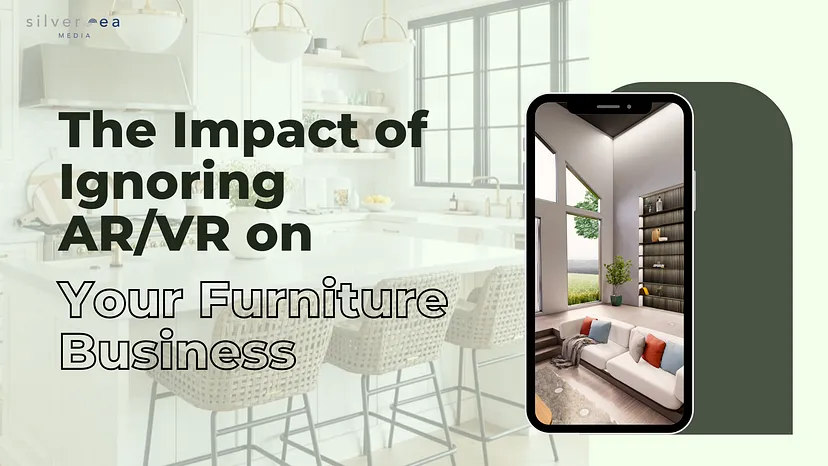Every detail counts in furniture shopping — getting the size, color, and style right for your space is critical. However, even detailed presentations in elaborately designed showroom spaces in furniture stores only help to a limited extent in imagining how the furniture will look in its intended place. This is where immersive technologies such as 3D, Virtual Reality (VR), and Augmented Reality (AR) come into play.
Ignoring immersive technologies in the furniture industry means missing out on golden opportunities to boost customer engagement, simplify purchases, and stand out in a crowded market. Dive into this article to uncover the potential consequences of lagging behind competitors who are already leveraging the power of AR/VR.
Immersive Technology is the Future of Furniture Sales
For furniture retail businesses, AR/VR has allowed companies to deliver unique customer experiences. With AR, customers can virtually place furniture items in their living spaces using smartphones or tablets, offering a realistic preview of how products fit and look in their homes. VR elevates this by creating fully immersive virtual showrooms, allowing customers to explore and interact with a three-dimensional space.
With the integration of AI-powered personal shopping assistants, these technologies offer personalized recommendations and insights that adapt in real-time to user preferences. Imagine getting expert guidance while virtually trying out different furniture pieces, all from the convenience of your own space.
Missing Out on AR/VR: What It Means for Your Business
1. Reduced Customer Engagement
AR/VR technology facilitates a deeper engagement by providing options to alter furniture finishes, colors, and textures. Interactive 3D models allow customers to view furniture items from all angles and project them directly into any live environment. In contrast, relying solely on static 2D visualizations limits interactive capabilities, resulting in reduced customer engagement.

2. Higher Return Rates
Traditional online displays often lead to purchase mistakes and a flood of returns. But with the magic of 3D & AR furniture visualizations, we’re changing the game. Customers can virtually test-drive their furniture, ensuring a perfect fit before hitting ‘buy.’ These accurate previews can boost confidence in purchase decisions and reduce return rates.
3. Limited Space and Reach
Picture this: You’ve got a stunning catalog of furniture, each piece designed to impress. But here’s the catch: traditional showrooms can only fit so much. Ignoring AR/VR means missing out on the chance to showcase your entire catalog in one virtual space, breaking free from reach limitations and space constraints. With immersive technology, the possibilities are endless. Customers worldwide can explore every corner of your collection from the comfort of their homes, no matter how vast or varied it may be.
4. Missed Marketing and Sales Opportunities
Incorporating AR/VR tech isn’t just a trend; it’s a powerhouse move that can skyrocket your engagement and sales. For instance, research from XR Today reveals that 57% of AR users are inclined to purchase from brands offering AR experiences. Moreover, a Shopify report indicates that products with 3D/AR content boast a 94% higher conversion rate than those without. These statistics underscore the pivotal role immersive technology plays in shaping consumer decisions, making it a crucial asset you wouldn’t want to overlook.
5. Weak Brand Positioning and Differentiation
In an era where consumers crave immersive experiences, failing to leverage immersive technologies could leave your brand trailing behind competitors. AR/VR not only enhances the shopping experience but also sets brands apart as innovative leaders in the industry. By offering interactive product visualizations and engaging showrooms, brands can captivate audiences and solidify their position as pioneers in the digital age.
Without this technological edge, your brand risks being perceived as outdated and lacking innovation, weakening its market position.
Read more about the benefits of adopting AR/VR in the furniture industry: https://silversea-media.com/virtual-showrooms-for-furniture-wholesalers-maximizing-efficiency-and-engagement/
As the shopping landscape evolves beyond traditional brick-and-mortar stores, the furniture industry is witnessing a seismic shift propelled by immersive technology. It’s a transformative moment, and furniture companies simply can’t afford to stand still.
Immersive technologies offer a plethora of benefits to the customer experience. Features like try-before-you-buy and AR furniture enhance customer satisfaction and contribute to higher retention rates and lower return rates. And on top of that, they enable businesses to tap into a new generation of tech-savvy customers who prioritize interactive and personalized shopping experiences.
Silversea Media has some valuable tips for furniture businesses navigating digital transformation. Gain instant access to our exclusive e-brochure for expert insights and tips!




